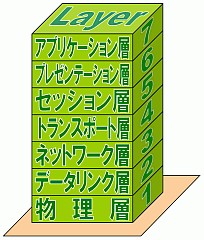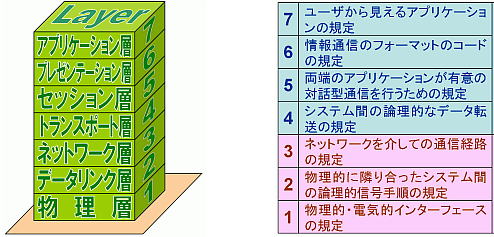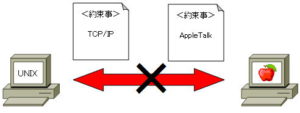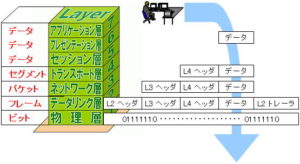OSI reference model
OSI reference model
In order to exchange data between computers, various protocols are required, ranging from physical forms such as cables to file transfer and applications.
What if these conventions were implemented in a single protocol?
Various machines exist on the network. There are different cable types, different connector shapes, and different applications. Doing all this in one protocol would be a huge undertaking.
What about protocol upgrades?
terrible!
It’s all remade!
Having one protocol to do everything is not very efficient.
Therefore, the International Organization for Standardization (ISO) has established the OSI reference model (Open System Interconnection) to enable data communication between different types of systems.
The OSI reference model is a reference model that divides the communication functions that a computer should have into seven layers. It is commonly called the OSI 7-layer model.

Modeling results in the following benefits:
for example,
If the interface with each layer does not change, there is no need to worry about other layers
You don’t have to worry about which cable to connect when sending e-mail, or whether your Internet connection is ADSL or FTTH.
E-mail data goes down from the application layer where MUA (software for sending and receiving e-mails: Outlook, etc.) is located to the lower layer, and passes through the connecting cable (physical layer) as an electrical signal (bit signal). It will reach your computer. The receiving party passes the received electrical signal from the lower layer to the upper layer, and finally delivers it to the other party’s MUA.
Can concentrate only on exchanging protocols with the same layer
By assigning roles to each layer, there is no need to worry about what the lower layer and upper layer protocols are doing. Each layer can concentrate on working with protocols on the same layer without worrying about the layers below or above.
* The OSI reference model is advocated by the ISO (International Organization for Standardization), but it is only a conceptual model, and protocols are not developed according to it. In practice, there are also protocols that span multiple layers.
Division of Roles in the OSI Reference Model
The OSI Reference Model is a model established by the International Organization for Standardization (ISO). In order to realize data communication between heterogeneous devices, the design policy of the network structure is defined by dividing it into 7 layers (layers). It is also commonly called the OSI 7-layer model.
● OSI 7-layer model

| hierarchy | name | explanation |
| 7th layer | Application layer (Applications layer) | Provide network services. Defines how data is exchanged between applications. |
| 6th layer | Presentation Layer | Defines the method of representing data exchanged in a session. Data conversion (character code: ASCII, EBCDIC, etc.) ・Compression is specified. |
| 5th layer | Session layer | Defines the procedure of a session (from start to end of communication). |
| 4th layer | Transport layer | It specifies how to communicate between two processes on each node. Responsible for retransmission, congestion handling, and reliable end-to-end communication. |
| 3rd layer | Network layer | It defines physical node addresses, communication methods between adjacent nodes, and so on. |
| 2nd layer | Data Link Layer | It defines physical node addresses, communication methods between adjacent nodes, and so on. |
| 1st layer | Physical layer | It specifies the physical electrical characteristics of signal lines, pin shapes, cable characteristics, modulation methods, and so on. |
In this way, by dividing roles in each hierarchy, changes in one hierarchy will not affect other hierarchies. As a result, functionality can be easily modified and extended at each layer.
For example, even if a twisted pair cable was used to connect to the network, but the connection is changed to a wireless connection, there is no need to change the protocols of layers above 3.
Advantages of the OSI Reference Model
- Even if the vendor (manufacturer) is different, communication compatibility can be maintained by using a common model.
- Even if the specifications of a specific layer are changed or modified, it does not affect other layers.
- Network communications can be divided into smaller manageable units.
- Understanding how each layer communicates makes learning the network easier.
And so on.


